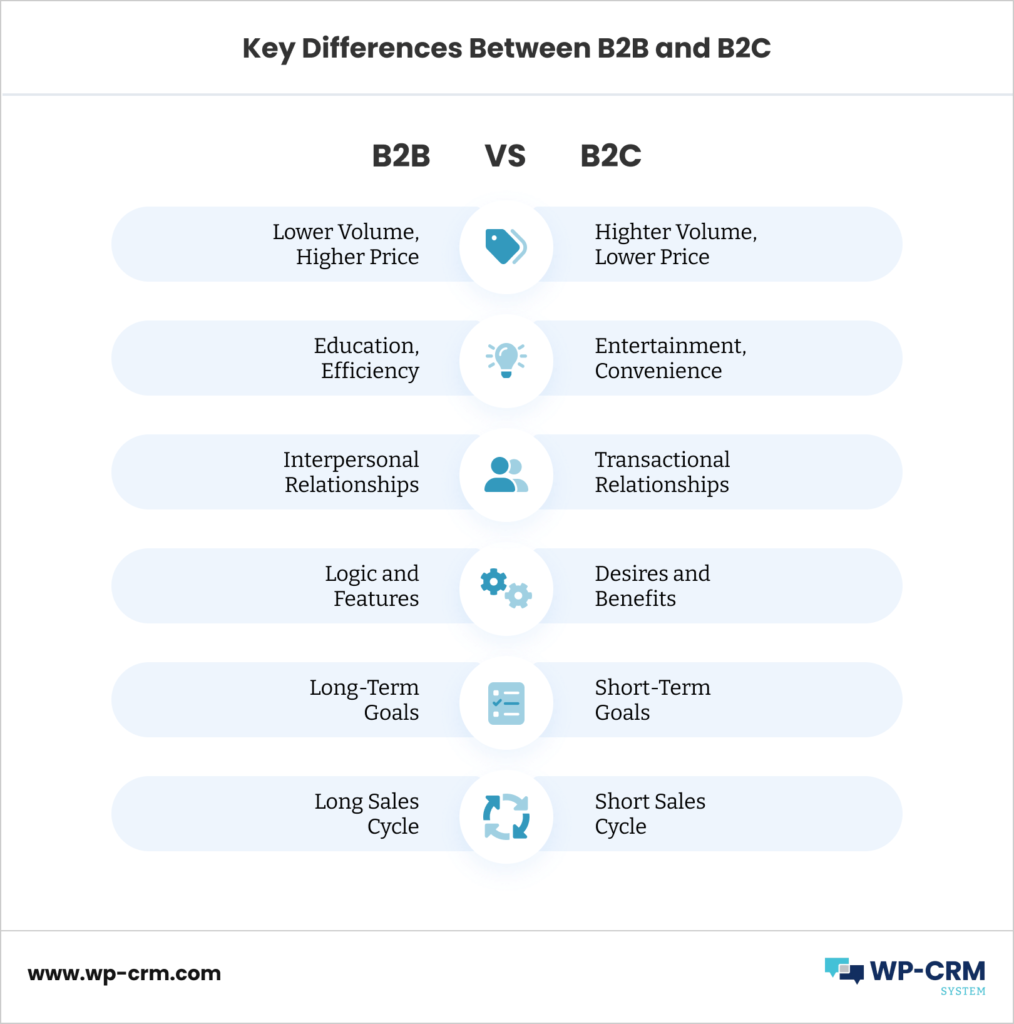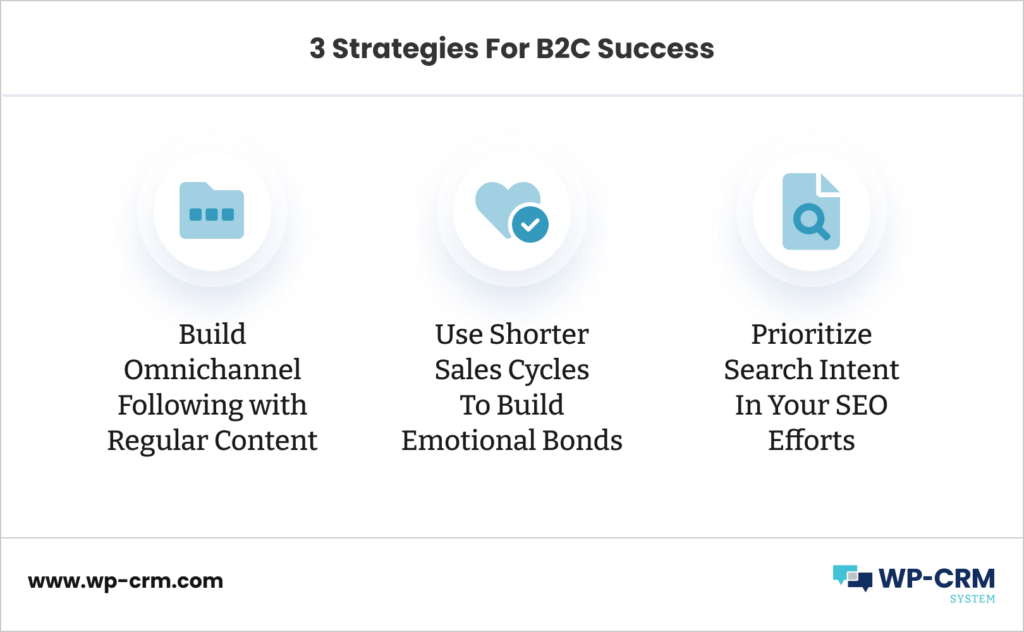What Is B2C? [Guide + Examples]
Before you start a business, it is especially important to choose between a B2C and B2B model. It’s easy to get caught up in the misconceptions of others and waste valuable time. Many business plans fail to take into account certain variable factors like SEO competitors, complexity, and talent acquisition. By taking these factors into account at the very beginning, you can ensure that your business has a better chance of success.
Many companies have kept the remote or hybrid work model post-pandemic as a coping mechanism. Thus, teams have become used to and dependent on business tech for internal and client communications. So, if you are an aspiring entrepreneur, you need to make sure you buckle up with the best small business software.
If your company website is built on WordPress, you’d be better off integrating your solutions on the dashboard for easy operation. WP-CRM is such customer relationship management tool that gives you that essential flexibility and transparency in client communications.
Any business owner would have likely heard the term “B2C” thrown around a lot. However, what are the characteristics of successful B2C companies? And more importantly, how can you use B2C marketing to reach new customers and grow your business?
In this guide, we’ll answer all of those questions and give you some examples of good B2C practices. Whether you’re just starting out your B2C business, not sure if this is the right model for you, or if you’re looking for fresh ideas, you’ve come to the right place.
B2C vs. B2B

The main difference between B2B and B2C businesses is the customers they target. B2B companies typically sell to other businesses that resell their products. On the other hand, B2C model enterprises frequently sell directly to the end consumer. This is the primary distinction between the two types of businesses. However, they also tend to operate differently and offer unique benefits.
For example, B2B businesses often have longer sales cycles. They need to build relationships with potential partners and convince them of the value of their products or services. In contrast, B2C companies can typically rely on more immediate sales, as consumers are generally more easily persuaded to make a purchase. However, B2C companies often have higher marketing costs. This is because they need to reach a wider audience through advertising and other marketing channels.
If you’re selling products or services to other businesses, then a B2B model is likely the best option. This option allows you to build strong customer relationships and offer unique benefits. However, it’s important to be aware of the potential pitfalls, such as longer sales cycles and higher marketing costs.
On the other hand, if you’re selling products or services directly to consumers, then a B2C model is likely the better choice. This type of business offers the advantage of immediate sales and lower marketing costs. However, it’s important to be aware that you’ll need to reach a wider audience through advertising and other marketing channels. Ultimately, the best decision for your business will depend on your specific products, services, and target market.
How To Have A Successful B2C company: 3 Key Strategies

Build A Following
These days, content is king. Whether you’re marketing to consumers or other businesses, your efforts should be focused on producing and distributing high-quality material. Content marketing is a form of inbound strategy that uses information to attract visitors to your company. Blog articles, videos, and social media posts are all examples of good content to raise brand awareness and build authority.
By creating compelling content, you’ll be able to attract more attention to your business, build a following of brand ambassadors, and establish yourself as an expert in your field. In today’s noisy online world, a strong content marketing strategy is essential for any business that wants to stand out from the competition.
In addition, you need to aim to connect with your (potential) customers on a human level on all channels you use for marketing your brand and content. How about a contest to win an add-on to a purchase of a new product? Make sure you keep an open mind, and also, be quick to reply and react to comments.
Take Advantage of Shorter Sales Cycles
The sales funnel is a journey that leads take as they move from being aware of a product or service to becoming a paying customer. While the exact steps and timeline vary from person to person, there is generally a lot of time and consideration that goes into each purchase.
On average, it takes eight “touches” before a person converts into a buyer. And in the case of a B2B marketing funnel, this number is likely to be even higher. That’s because business purchases are often much more expensive and complex than consumer purchases, so there’s more at stake for the buyer. As a result, B2B buyers tend to move more slowly and carefully through the sales funnel. So if you’re selling products or services to businesses, don’t expect them to convert overnight.
However, when it comes to B2C products, businesses are in a much better position. Consumers are more likely to make impulsive purchases, especially via social media. In addition, end consumers may not always make purchasing decisions based on rational analysis. Instead, they frequently opt to support organizations based on a sense of loyalty or convenience. As a result, businesses that focus on building a solid emotional bond with their consumers are more likely to succeed.
Have A Search Intent Strategy

B2C companies often make the mistake of assuming that all Google searches are the same. However, searcher intent varies greatly depending on the query. People who are looking for information about a product are in a different stage of the buying cycle as opposed to those who are ready to purchase.
As a result, B2C companies need to optimize their content for each stage of the buying cycle individually. By understanding searcher intent, you can ensure that your content is always relevant and helpful, ultimately driving more sales.
Searcher intent is the reason a person types a question or keyword into a search engine. Is it to gain information, find a location, or is it to make an actual purchase? For example, someone who types “best CRM systems” into Google is likely comparison shopping, while someone who searches for “how to integrate CRM in WordPress” is probably looking for informational content.
As a B2C marketer, it is important to understand searcher intent so that you can create content that appeals to your target audience. By tailoring your content to the specific needs of each type of searcher, you can ensure that your website appears prominently in search results for this particular query.
Final Thoughts
In order to be successful in the B2C market, it’s important to understand the different strategies you can employ. Building an omnichannel following with regular content, using shorter sales cycles to build emotional bonds, and prioritizing search intent are all great ways to ensure success. If you’re looking for a CRM WordPress plugin that will help make client communication easier, WP-CRM is a great option. It’s easy to use and helps keep your business organized.
